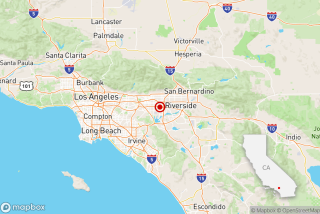Ontario Airport Greets International Flight
- Share via
Descending from a dull brown sky, the first international passenger flight in years arrived at Ontario International Airport on Monday.
Its origin: Ontario, Canada. And officials swear it wasn’t a gimmick.
They say that enough people want to fly between the two Ontarios to support a daily Air Canada flight, and that the new international service marks the airport’s growing importance in Southern California’s regional air transportation system.
The airport’s year-old, $269-million terminal complex is surrounded by the sights--and smells--of nearby dairy farms. Still, Ontario is seen as a strategic location for several reasons. It serves the nation’s fastest growing counties: Riverside and San Bernardino.
While expansion efforts at Los Angeles International and Orange County face daunting opposition, officials hope Ontario can be a relief valve for growing regional demand.
“As we see this giant boom in demand, LAX simply can’t handle the capacity,” said Lydia Kennard, executive director of Los Angeles World Airports, an L.A. city department that operates L.A. International, Ontario, Van Nuys and Palmdale airports.
About 6.5 million people a year use the Ontario airport, compared with 64 million at L.A. International. But regional planners predict that by the year 2020, as the number of passengers across the region doubles, more than 20 million passengers might take off from Ontario, a growing city of 147,000 people about 35 miles east of downtown L.A.
If the airport reaches the 10 million mark two years in a row, an agreement between the airlines and Los Angeles will trigger construction of two terminals, making a total of four.
Some experts say that could lead to the same noise and congestion problems that stall expansion in L.A. and Orange counties.
“As you get to 20 million passengers a year, you’re going to see some pretty significant noise impacts on mostly Latino populations,” said Michael Armstrong, senior aviation planner of the Southern California Assn. of Governments.
Yet Ontario city officials hope the airport expansion creates even more business and establishes the area as a hub for visitors to Southern California. They cite major new shopping malls and distribution centers in the area, including those used by Toyota, New Balance and Porsche, which are displacing the once ubiquitous dairy industry.
“We are a gateway to Southern California,” said Ontario City Manager Gary Devereaux. “What a lot of people don’t realize is that it’s a lot easier to get to Disneyland from here than most parts of the region.”
Ironically, Ontario was named last century by emigres from Canada’s Ontario, but there is little direct connection between the two areas today.
Air Canada officials said they studied the semirural Ontario airport for more than a year before they determined it could support a daily flight to Toronto.
“Toronto is one of our most profitable routes, especially with the movie industry,” said Frank Leggett, regional sales manager for the airlines. He added that many Canadian “snowbirds” fly to California to go to Palm Springs and the desert, which are far closer to Ontario than to Los Angeles.
Passengers can also travel more easily to the San Gabriel and Pomona valleys and northern Orange County. In fact, officials fighting plans to convert the El Toro Marine Corps Air Station into an international airport argue that Ontario is close enough to meet Orange County’s growing demand for air service.
Although some experts say Ontario could relieve the burdens on other airports, they say it’s not a panacea.
“Most of the people in Orange County will find LAX as convenient as Ontario,” said Armstrong, the aviation planner. “El Toro works well because it would serve San Diego too. Ontario can’t serve San Diego.”
Now, only L.A. International and Ontario are designated as international airports for the region. Ontario has a customs inspection facility, but it is not staffed because Canadians are checked by U.S. officers before they board in Canada and do not require such services upon arrival.
In the early 1990s, before the two new airport terminals were built, Aeromexico offered three daily flights from Ontario to major cities south of the border, officials said. Those flights were abandoned within six months because the Inland Empire could not support that many business flights.
Studies now show that one business flight and one leisure flight, to a resort city in Mexico, would best serve the area, officials said.
“We’re trying to get Aeromexico and Mexicana to start service,” said Martin Obregon, senior management analyst at Los Angeles World Airports. “That’s our next target.”
But Monday, all eyes were focused to the north as officials held a boosterish reception before the Air Canada jet arrived at Gate 204 about noon. Flanked by a pastoral scene of Canada and a crystal-blue ocean wave that apparently was supposed to represent the Inland Empire, officials declared a new era for the airport.
“We are very pleased to see this airport become truly international,” said L.A. City Councilwoman Ruth Galanter, whose district includes the area around L.A. International and who opposes its role as the only means to deal with increased regional air traffic needs.
Led off the plane by a bagpipe player and a real Mountie, the passengers who filed off Flight 670 said that landing in Ontario helped them avoid the sprawling terminals in L.A. Ray Wilson, from Riverside, often travels to Toronto on business, and normally boards a turboprop flight from Ontario to L.A. International to avoid the long commute.
“Oh man, drive to LAX? That’s a two-hour drive,” he said.
Mike Harvey, a Canadian businessman, said: “This makes it a heck of a lot easier to get into parts of Southern California, like San Diego and Orange County.”
More to Read
Sign up for The Wild
We’ll help you find the best places to hike, bike and run, as well as the perfect silent spots for meditation and yoga.
You may occasionally receive promotional content from the Los Angeles Times.







